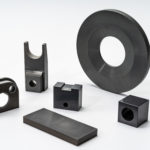Silicon nitride (Si3N4) is one of the most advanced engineering ceramics on the market, providing an outstanding blend of mechanical and thermal properties. Each individual member of the Si3N4 ceramic family is comprised of silicon (Si) and nitrogen (N) in a densely-packed atomic arrangement of high-strength intra-structural covalent bonds. This provides the basis for the material’s high thermal and mechanical performance, as well as interesting electrical properties which can be tailored to specific applications.

The electrical properties of ceramics are often overlooked in favour of their ability to withstand abrasion, corrosion, and extreme heat. However, the electrical conductivity and resistance of a ceramic can be just as critical depending upon the machining requirements and the end-product operating conditions. Si3N4 is unique among ceramics for its novel electrical properties. This blog post will explore why.
The Importance of a Ceramic’s Electrical Properties
Silicon is one of the leading semiconductors in the electrical and energy generation industry, with a variable resistivity that enables electrical currents to move selectively through the material. This behaviour has been instrumental in the manufacture of organic photovoltaics (OPVs) for converting solar energy into electricity using an electronic junction. In order to unlock these unique electrical properties, however, silicon must be doped with pentavalent or trivalent atoms.
The semiconducting nature of silicon makes it the ideal base material for a broad range of alloys in the electronics industry. Its resistivity can be heightened to essentially eliminate its electrical conductance for refractory and mechanical applications, enabling Si3N4 alloys to be used in the manufacture of complex components such as motors, wind turbines, and bearings in electrical generation units. This improved resistance to electrical current reduces the potential for malfunction due to the propagation of stray electrical transfer through the material.
- For more information on the use of Si3N4 ceramics in advanced electronics, read about our article: Future of Technical Ceramics: AI, IoT & Industry 4.0
Electrical Conductivity/Resistance Explained
Electrical resistance is expressed in Ohms (Ω cm), a value that determines how readily an electrical current can flow through a material. This measurement is based on Ohms Law, which states that a voltage (V) will flow in an electrical current (I) between two connected points unless restricted by factors such as the nature of the propagating material. Resistance is therefore equal to the charge resisted across a material of known length under distinct temperature conditions.

Si3N4 is an extremely good insulator of electricity, supporting comprehensive resistance to electrical charge propagation across short lengths and material cross-sections. Each of the Si3N4 grades available from International Syalons boasts a high electrical resistance of 1012 Ω cm, with the notable exception of Syalon 501.
Syalon 501 was deliberately engineered to allow electrical conductivity, which means this advanced Si3N4 product is suitable for electro-discharge machining (EDM). This represents a low electrical resistivity of 7.2 x 10-4 Ω cm, mitigating it from use in some electronics applications. Yet it enables the fabrication of intricate components from high corrosion-resistant materials, supporting the manufacture of moulds for metal and plastic forming.
The electrical resistivity of Si3N4 is a fundamental principle in its mechanical and thermal performance, whether it is conceived as an insulator or a conductor.
- For more information, read The Benefits of Electrically Conductive Silicon Nitride
Si3N4 from International Syalons
International Syalons was the first company to engineer a proprietary Si3N4 product for commercial applications, and in the years since we have expanded our product range to include innovative solutions for demanding applications.
If you have any questions for the International Syalons team, simply contact us directly.



